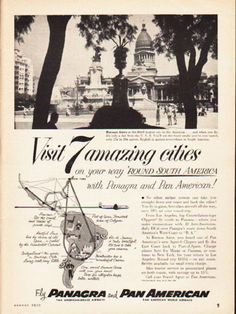CXXXV
From
his earliest days in the aviation business, when he was both owner and pilot of
Long Island Airways, Juan Trippe’s dream was to make air travel accessible to
Everyman. He wanted people to be excited
about flying. Unlike too many business owners today, for Trippe, it wasn’t just
about the bottom line, it was about offering customer passengers a unique
experience. Juan Trippe wanted people to
feel that they were traveling to exotic, romantic destinations, and everything
about Pan American Airways marketing was devised to reinforce that idea. Unlike
air travel in 2016, air travel circa 1930 wasn’t about getting to your
destination as it was about the voyage itself. From the days of the earliest Fokker Trimotors
in 1928, Juan Trippe promoted flying as an extraordinary experience.
The
Trimotors, with their engines roaring just beyond the windows of the
uninsulated cabins, were presented to the passengers as flying lounges. The seats were of cushioned rattan, giving the
interior a pleasantly tropical feel. The advertisements discreetly reminded
passengers, too, that there was a “toilet room” aboard. Most people who flew down
to Havana in 1929 were going there to evade Prohibition. They’d need that “toilet
room” on the way back, whichever end needed the relief. A passenger to the islands
was also permitted a maximum of 30 pounds of luggage (extra weight came at a
cost); on the way home, much of it clanked. The Customs men usually pretended
not to hear.
 |
|
In
an era when people actually read ads, this one presented Pan American’s full
1929 flight schedule
|
 |
|
In
the same era, Pan American instituted “Rail-Air Service.” From New York, one
entrained southward on either the “Havana Special,” the “Florida Special,” or
the “Palmetto Special” to arrive in Miami, from whence Pan American would whisk
you to “the Indies.” Passengers were promised “gay, tropic colors” and, for the
more practical-minded, “radio [to] keep you in touch with either shore.” All
this was yours at the hands of “veteran pilots.” Midwestern travelers rode
either the “Floridian,” the “Dixie Limited” or the “Flamingo” south from
Chicago
|
 |
|
The
Florida East Coast Railway (FECRR), Henry Flagler’s brainchild, carried
passengers south from New York to Miami and Key West via “a modern transportation
system” (for those who had traveled the South by rail in other areas. Pan Am
promoted flying as “the easiest way --- and the best!” to get to Havana; one
could also take the ferry. After the 1935 hurricane destroyed the Overseas
Railway through the Keys, flying from Miami became the most practical solution
for Northern travelers to go South
|
 |
|
“The
Havana Special” from New York burned coal. Neither the FECRR nor the”Dixie
Limited’s” Chicago & Eastern Illinois (C&EI) survived into the ‘electric’
or ‘streamlined’ eras
|
 |
|
The
“Dixie Limited” and its sister train, the “Dixie Flyer” both promised
passengers “Air Conditioned Equipment”
|


 |
|
“The
Milk Run”: One of the more interesting trivia
tidbits about the “Dixie Limited” was that in 1938 C&EI tried running the
train on dried milk briquettes rather than coal. They burned hotter and faster
than coal and the supply ran out, forcing the Engineer to switch back to fossil
fuel. But the train did make better time. The experiment was never repeated,
however
|
The
advent of the Sikorsky S-42 revolutionized Pan American’s approach to aviation.
With the introduction of the long-range flying boat, Pan American Airways could
introduce the American public to “Clipper Cruises” not unlike those being
promoted by Dr. Hugo Eckener aboard the Graf
Zeppelin.
 |
|
Juan
Trippe wanted Everyman to enjoy the pleasures of the harbor, wherever the
harbor was
|
Clipper
Cruises (also called “Skyway Cruises”) were exactly that: Instead of taking a
seagoing vessel to visit exotic ports of call one took an airgoing vessel.
Clipper Cruises involved multiple stops in multiple cities over a multiple day
itinerary. They were “just” pleasure cruises, limited to 30 passengers per
cruise, and they included hotel accommodations and ground and river
transportation as well.
 |
|
If
you couldn’t get away for a Clipper Cruise, you could at least get away for a
romantic weekend in the Bahamas
|
The
whole idea was Trippe’s, meant to open Americans’ eyes to new, fascinating
horizons, and he priced them at a surprisingly inexpensive rate because he
wanted people to travel --- six weeks in 21 different countries would cost the
traveler only $1,200.00 --- but this at a time, 1931, when the average annual
income of a United States citizen was $1,342.00, apples were ten cents a pound,
a man’s work shirt was sixty-five cents, and steak was twenty cents a pound. A
monthly car payment hovered around $15.00 per month, and a three bedroom two
bath house might carry a monthly mortgage payment of $45.00.
 |
|
Compared
to the Twenty-Teens, the price of a Pan American Clipper Cruise was
ridiculously low and the level of service was incredibly high. Pan Am had a
vested interest in assuring that its passengers were safe not only in the air
but on the ground in foreign climes
|

 |
|
Although
the aircraft evolved over time, Pan American’s elegant promise of the good life
remained always the same
|




No comments:
Post a Comment